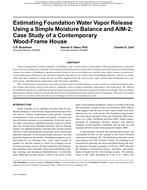Description
Proper management of indoor humidity in buildings is an essential aspect of durability. Following dissipation of moisture from construction materials, humidity levels during normal operation are generally assumed to primarily depend on the building volume, the number of building occupants and their behavior, the air exchange rate, and the water vapor content of outdoor air.
A potentially large additional source of indoor humidity that often is not considered is the building foundation, which is in contact with earth that commonly is damp. Recent work has suggested that the rate of water vapor release from foundations may vary with season, with foundation temperature, and with indoor humidity.
This work presents results from a case study of a house with a wood foundation system in which we estimate foundation moisture release given basic interior and exterior conditions, such as relative humidity, temperature, and wind speed. The Alberta air infiltration model was calibrated using tracer gas measurements in the house and used to model air exchange. We use a simplified moisture balance model to estimate the hourly rate of foundation moisture release from the basement. This rate is presented and shown to correlate with stack-driven air exchange for this wood foundation system.
Citation: Thermal Performance, International Conference, 2010
Product Details
- Published:
- 2010
- File Size:
- 1 file , 5.4 MB
- Product Code(s):
- D-BUILDINGSXI-29




